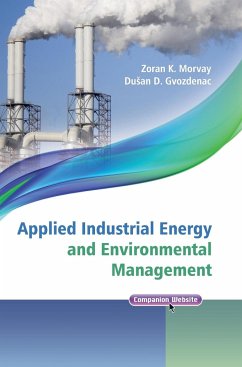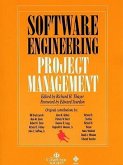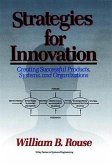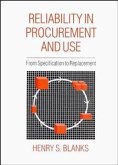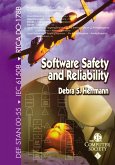- Gebundenes Buch
- Merkliste
- Auf die Merkliste
- Bewerten Bewerten
- Teilen
- Produkt teilen
- Produkterinnerung
- Produkterinnerung
Industrial energy systems channel fuels and power into a variety of energy types such as steam, direct heat, hot fluids and gases, and shaft power for compressors, fans, pumps, and other machine-driven equipment. All of these processes impact the environment and are impacted by external energy and environmental policies and regulations. Therefore many environmental management issues are closely related to energy use and efficiency. Applied Industrial Energy and Environmental Management provides a comprehensive and application oriented approach to the technical and managerial challenges of…mehr
Andere Kunden interessierten sich auch für
![Kanban Change Leadership Kanban Change Leadership]() Klaus LeopoldKanban Change Leadership92,99 €
Klaus LeopoldKanban Change Leadership92,99 €![Software Engineering Project Management Software Engineering Project Management]() Edward YourdonSoftware Engineering Project Management144,99 €
Edward YourdonSoftware Engineering Project Management144,99 €![Strategies for Innovation Strategies for Innovation]() William B RouseStrategies for Innovation227,99 €
William B RouseStrategies for Innovation227,99 €![Reliability in Procurement and Use Reliability in Procurement and Use]() Henry S BlanksReliability in Procurement and Use593,99 €
Henry S BlanksReliability in Procurement and Use593,99 €![Telecommunications Network Management Telecommunications Network Management]() Telecommunications Network Management240,99 €
Telecommunications Network Management240,99 €![Global Logistics Management Global Logistics Management]() Global Logistics Management132,99 €
Global Logistics Management132,99 €![Software Safety Reliability Software Safety Reliability]() Debra S HerrmannSoftware Safety Reliability147,99 €
Debra S HerrmannSoftware Safety Reliability147,99 €-
-
-
Industrial energy systems channel fuels and power into a variety of energy types such as steam, direct heat, hot fluids and gases, and shaft power for compressors, fans, pumps, and other machine-driven equipment. All of these processes impact the environment and are impacted by external energy and environmental policies and regulations. Therefore many environmental management issues are closely related to energy use and efficiency. Applied Industrial Energy and Environmental Management provides a comprehensive and application oriented approach to the technical and managerial challenges of efficient energy performance in industrial plants. Written by leading practitioners in the field with extensive experience of working with development banks, international aid organizations, and multinational companies, the authors are able to offer real case studies as a basis to their method. The book is divided into three main parts: * Part one describes Energy and Environmental Management Systems (EEMS) in current use and management techniques for energy and environmental performance improvement. * Part two focuses on the engineering aspects of industrial energy management, describing main industrial energy systems and how to analyse and improve their energy performance. * Part three is the TOOLBOX on an accompanying website, which contains data, analytical methods and questionnaires as well as software programs, to support the practical application of the methods elaborated on in the first two parts of the book. This book will be a valuable resource to practising energy and environmental management engineers, plant managers and consultants in the energy and manufacturing industries. It will also be of interest to graduate engineering and science students taking courses in industrial energy and environmental management.
Hinweis: Dieser Artikel kann nur an eine deutsche Lieferadresse ausgeliefert werden.
Hinweis: Dieser Artikel kann nur an eine deutsche Lieferadresse ausgeliefert werden.
Produktdetails
- Produktdetails
- Verlag: Wiley
- Seitenzahl: 456
- Erscheinungstermin: 3. Dezember 2008
- Englisch
- Abmessung: 250mm x 175mm x 29mm
- Gewicht: 966g
- ISBN-13: 9780470697429
- ISBN-10: 0470697423
- Artikelnr.: 26009993
- Herstellerkennzeichnung
- Libri GmbH
- Europaallee 1
- 36244 Bad Hersfeld
- gpsr@libri.de
- Verlag: Wiley
- Seitenzahl: 456
- Erscheinungstermin: 3. Dezember 2008
- Englisch
- Abmessung: 250mm x 175mm x 29mm
- Gewicht: 966g
- ISBN-13: 9780470697429
- ISBN-10: 0470697423
- Artikelnr.: 26009993
- Herstellerkennzeichnung
- Libri GmbH
- Europaallee 1
- 36244 Bad Hersfeld
- gpsr@libri.de
Dr. Z. K. Morvay, holds a PhD in electrical engineering and has more than 20 years of teaching experience at universities in Croatia, the UK and Thailand. During the early 1990s he worked for a UK energy and environmental consultancy firm, managing projects for international development banks and aid organizations, technical assistance projects for governmental and consultancy projects and feasibility studies for industry. he moved to Thailand to manage the local office just before the economic crisis in South East Asia in 1997. He developed, designed and managed the implementation of a number of energy and environmental management projects for large industrial international companies from Japan, the USA, the UK and Thailand, which often evolved into cost management projects because the theme of the day at that time was cost cutting. In addition, he has practical experience of change management, training needs assessment and support for organizational learning. He is the author of a number of professional papers and of a handbook and manuals on energy and environmental subjects. Currently, he manages a national energy efficiency project in Croatia. Dr. D. D. Gvozdenac is Professor and Chairman of Thermal Engineering at the University of Novi Sad Serbia and Thailand. This is complemented by having spent the last 15 years as an international consultant working on energy projects in Europe, Africa, South East Asia and China. He was also the director of a national energy efficiency agency and a regional energy efficiency centre. He has managed a number of energy audits in industry, solving the problems of energy and utility systems, and has developed best practice and preventive maintenance manuals for industrial equipment and machines. He is the author of a number of professional papers, editor of conference proceedings and author of training manuals. Currently, he is working on the development of a national cogeneration project in Thailand.
About the Authors.
Preface.
Introductory Chapter: Framework for Energy and Environmental Management in
Industry.
1. Introduction.
2. Energy Use by Industrial Operations.
3. Environmental Impacts of Industrial Operations.
4. End Use Energy Efficiency.
5. Efficiency of Using Raw Materials.
6. Global Energy Policy Framework.
7. Energy and Environmental Policies.
7.1 Integrated Pollution Prevention and Control (IPPC).
7.2 Energy Markets Deregulation and Liberalization.
7.3 Consumers' Choice in the Liberalized Energy Market.
7.4 Emissions Trading.
7.5 Compulsory Energy Efficiency Programs.
7.6 Voluntary Programs.
8. Industries' Self-Motivation for Effective Energy and Environmental
Performance.
9. Environmentally Responsible Investing.
10. Where to Look for Energy and Environmental Performance Improvements.
11. Bibliography.
Part I: Energy and Environmental Management System in Industry (EEMS).
1. Introducing the Energy and Environmental Management System.
1.1 Introduction.
1.2 Definition of terms.
1.3 Energy and Environmental Management System.
1.4 Objectives of Energy and Environmental Management.
1.5 Dynamics of Energy and Environmental Management.
1.6 Human Aspects of Energy and Environmental Management.
1.7 Initiating Training, Awareness and Motivation Programs.
1.8 Bibliography.
2. The Energy and Environmental Management Concept.
2.1 Introduction.
2.2 Interactions between Energy and Production.
2.3 Energy Cost Centers.
2.4 Assigning Responsibilities for Energy and Environmental Performance.
2.6 Effective Use of Energy and Environmental Performance Indicators.
2.7 Concept of Energy and Environmental Management System.
2.8 Context of Energy and Environmental Management.
2.9 Bibliography.
3. Relationship between Energy Use and Production Volume.
3.1 Introduction.
3.2 Energy/Production Relationship by Design.
3.3 Energy/Production Relationship by Standard Operational Procedure.
3.4 Presenting the Dynamics of the Energy/Production Relationship by
Scatter Diagram.
3.5 Interpretation of Energy/Production Data Pattern on the Scatter
Diagram.
3.6 Statistical Methods for Energy/Production Variability Analysis.
3.7 Meaning and Use of the Regression Line in Energy Performance
Evaluation.
3.8 Summary of Presenting and Analyzing the Energy/Production Relationship.
3.9 Bibliography.
4. Evaluating the Performance of Energy and Environmental Management
Practice.
4.1 Evaluation of Past Performance.
4.2 Energy and Environmental Auditing.
4.3 Evaluating Organizational Aspects.
4.4 Evaluating Operational Aspects.
4.5 Setting a Baseline for Monitoring Performance Improvements.
4.6 Setting Initial Targets for Performance Improvement.
4.7 Monitoring Energy and Environmental Performance.
4.8 Verifying Performance Improvements - CUSUM Technique.
4.9 Moving Toward Targets - Process of Change.
4.10 Bibliography.
5. Implementation of the Energy and Environmental Management System.
5.1 Introduction.
5.2 Phases of EEMS Implementation Process.
5.3 Preparation and Planning.
5.4 Implementation Plan.
5.5 EEMS Operation.
5.6 Learning Through EEMS Operation.
5.7 Continuity and Communication.
5.8 Integration of EEMS with Business Management System.
6. Energy and Environmental Management as a Driver for Integrated
Performance Management.
6.1 Introduction.
6.2 Integrated Performance Management in Operations.
6.3 Strategic Aspects of Performance Management.
6.4 Integrated Performance Measurement System.
6.5 Integrated Performance Management.
6.6 Conclusion.
6.7 Bibliography.
Part II: Engineering Aspects of Industrial Energy Management.
1. Introduction to Industrial Energy Systems.
1.1 Introduction.
1.2 Industrial Energy Systems Analysis.
2 Industrial Steam System.
2.1 System Description.
2.1.1 Boilers.
2.3 Principles of Performance Analysis.
2.4 Analysis of Boiler Performance.
2.5 Factors Influencing Boiler Performance.
2.6 Opportunities for Boiler Performance Improvement.
2.7 Software for Boiler Performance Analysis.
2.8 Boiler Performance Monitoring.
2.9 Steam Distribution and Condensate Return System.
2.10 Condensate Return System.
2.11 Environmental Impacts.
2.12 Bibliography.
3. Industrial Electric Power System.
3.1 Introduction.
3.2 Description of Industrial Electric Power Systems.
3.3 Basic Terms.
3.4 Tariff System.
3.5 Main Components of Industrial Electric Power Systems.
3.6 Performance Assessment of Industrial Electric Power Systems.
3.7 Performance Improvement Opportunities.
3.8 Maintenance Considerations.
3.9 Performance Monitoring.
3.10 Environmental Impacts.
3.11 Bibliography.
4. Compressed Air System.
4.1 System Description.
4.2 Performance Analysis.
4.3 Performance Improvement Opportunities.
4.4 Performance Monitoring.
4.5 Example: Detailed Energy Audit of Compressed Air System.
4.6 Example: Comparison of Load/Unload and Pump-up Tests.
4.7 Bibliography.
5. Refrigeration System.
5.1 Description of System.
5.2 Performance Definitions.
5.3 Performance Analysis.
5.4 Performance Improvement Opportunities.
5.5 Performance Monitoring.
5.6 Example: Improvement of ChilledWater System Operation.
5.7 Bibliography.
6. Industrial Cogeneration.
6.1 System Description.
6.2 Principles of Operation.
6.3 Types of Industrial Cogeneration Plants.
6.4 Operational Modes of Cogeneration Systems.
6.5 Performance Definition.
6.6 Factors Influencing Performance.
6.7 Economic Aspects of Cogeneration as a Performance Improvement Measure.
6.8 Performance Assessment.
6.9 Performance Monitoring and Improvement.
6.10 Environmental Impacts 415.
6.11 Case Study: Drying Kiln (Gas Turbine Operation Philosophy
Improvement).
6.12 Bibliography.
Part III: Toolbox - Fundamentals for Analysis and Calculation of Energy and
Environmental Performance.
Index.
Preface.
Introductory Chapter: Framework for Energy and Environmental Management in
Industry.
1. Introduction.
2. Energy Use by Industrial Operations.
3. Environmental Impacts of Industrial Operations.
4. End Use Energy Efficiency.
5. Efficiency of Using Raw Materials.
6. Global Energy Policy Framework.
7. Energy and Environmental Policies.
7.1 Integrated Pollution Prevention and Control (IPPC).
7.2 Energy Markets Deregulation and Liberalization.
7.3 Consumers' Choice in the Liberalized Energy Market.
7.4 Emissions Trading.
7.5 Compulsory Energy Efficiency Programs.
7.6 Voluntary Programs.
8. Industries' Self-Motivation for Effective Energy and Environmental
Performance.
9. Environmentally Responsible Investing.
10. Where to Look for Energy and Environmental Performance Improvements.
11. Bibliography.
Part I: Energy and Environmental Management System in Industry (EEMS).
1. Introducing the Energy and Environmental Management System.
1.1 Introduction.
1.2 Definition of terms.
1.3 Energy and Environmental Management System.
1.4 Objectives of Energy and Environmental Management.
1.5 Dynamics of Energy and Environmental Management.
1.6 Human Aspects of Energy and Environmental Management.
1.7 Initiating Training, Awareness and Motivation Programs.
1.8 Bibliography.
2. The Energy and Environmental Management Concept.
2.1 Introduction.
2.2 Interactions between Energy and Production.
2.3 Energy Cost Centers.
2.4 Assigning Responsibilities for Energy and Environmental Performance.
2.6 Effective Use of Energy and Environmental Performance Indicators.
2.7 Concept of Energy and Environmental Management System.
2.8 Context of Energy and Environmental Management.
2.9 Bibliography.
3. Relationship between Energy Use and Production Volume.
3.1 Introduction.
3.2 Energy/Production Relationship by Design.
3.3 Energy/Production Relationship by Standard Operational Procedure.
3.4 Presenting the Dynamics of the Energy/Production Relationship by
Scatter Diagram.
3.5 Interpretation of Energy/Production Data Pattern on the Scatter
Diagram.
3.6 Statistical Methods for Energy/Production Variability Analysis.
3.7 Meaning and Use of the Regression Line in Energy Performance
Evaluation.
3.8 Summary of Presenting and Analyzing the Energy/Production Relationship.
3.9 Bibliography.
4. Evaluating the Performance of Energy and Environmental Management
Practice.
4.1 Evaluation of Past Performance.
4.2 Energy and Environmental Auditing.
4.3 Evaluating Organizational Aspects.
4.4 Evaluating Operational Aspects.
4.5 Setting a Baseline for Monitoring Performance Improvements.
4.6 Setting Initial Targets for Performance Improvement.
4.7 Monitoring Energy and Environmental Performance.
4.8 Verifying Performance Improvements - CUSUM Technique.
4.9 Moving Toward Targets - Process of Change.
4.10 Bibliography.
5. Implementation of the Energy and Environmental Management System.
5.1 Introduction.
5.2 Phases of EEMS Implementation Process.
5.3 Preparation and Planning.
5.4 Implementation Plan.
5.5 EEMS Operation.
5.6 Learning Through EEMS Operation.
5.7 Continuity and Communication.
5.8 Integration of EEMS with Business Management System.
6. Energy and Environmental Management as a Driver for Integrated
Performance Management.
6.1 Introduction.
6.2 Integrated Performance Management in Operations.
6.3 Strategic Aspects of Performance Management.
6.4 Integrated Performance Measurement System.
6.5 Integrated Performance Management.
6.6 Conclusion.
6.7 Bibliography.
Part II: Engineering Aspects of Industrial Energy Management.
1. Introduction to Industrial Energy Systems.
1.1 Introduction.
1.2 Industrial Energy Systems Analysis.
2 Industrial Steam System.
2.1 System Description.
2.1.1 Boilers.
2.3 Principles of Performance Analysis.
2.4 Analysis of Boiler Performance.
2.5 Factors Influencing Boiler Performance.
2.6 Opportunities for Boiler Performance Improvement.
2.7 Software for Boiler Performance Analysis.
2.8 Boiler Performance Monitoring.
2.9 Steam Distribution and Condensate Return System.
2.10 Condensate Return System.
2.11 Environmental Impacts.
2.12 Bibliography.
3. Industrial Electric Power System.
3.1 Introduction.
3.2 Description of Industrial Electric Power Systems.
3.3 Basic Terms.
3.4 Tariff System.
3.5 Main Components of Industrial Electric Power Systems.
3.6 Performance Assessment of Industrial Electric Power Systems.
3.7 Performance Improvement Opportunities.
3.8 Maintenance Considerations.
3.9 Performance Monitoring.
3.10 Environmental Impacts.
3.11 Bibliography.
4. Compressed Air System.
4.1 System Description.
4.2 Performance Analysis.
4.3 Performance Improvement Opportunities.
4.4 Performance Monitoring.
4.5 Example: Detailed Energy Audit of Compressed Air System.
4.6 Example: Comparison of Load/Unload and Pump-up Tests.
4.7 Bibliography.
5. Refrigeration System.
5.1 Description of System.
5.2 Performance Definitions.
5.3 Performance Analysis.
5.4 Performance Improvement Opportunities.
5.5 Performance Monitoring.
5.6 Example: Improvement of ChilledWater System Operation.
5.7 Bibliography.
6. Industrial Cogeneration.
6.1 System Description.
6.2 Principles of Operation.
6.3 Types of Industrial Cogeneration Plants.
6.4 Operational Modes of Cogeneration Systems.
6.5 Performance Definition.
6.6 Factors Influencing Performance.
6.7 Economic Aspects of Cogeneration as a Performance Improvement Measure.
6.8 Performance Assessment.
6.9 Performance Monitoring and Improvement.
6.10 Environmental Impacts 415.
6.11 Case Study: Drying Kiln (Gas Turbine Operation Philosophy
Improvement).
6.12 Bibliography.
Part III: Toolbox - Fundamentals for Analysis and Calculation of Energy and
Environmental Performance.
Index.
About the Authors.
Preface.
Introductory Chapter: Framework for Energy and Environmental Management in
Industry.
1. Introduction.
2. Energy Use by Industrial Operations.
3. Environmental Impacts of Industrial Operations.
4. End Use Energy Efficiency.
5. Efficiency of Using Raw Materials.
6. Global Energy Policy Framework.
7. Energy and Environmental Policies.
7.1 Integrated Pollution Prevention and Control (IPPC).
7.2 Energy Markets Deregulation and Liberalization.
7.3 Consumers' Choice in the Liberalized Energy Market.
7.4 Emissions Trading.
7.5 Compulsory Energy Efficiency Programs.
7.6 Voluntary Programs.
8. Industries' Self-Motivation for Effective Energy and Environmental
Performance.
9. Environmentally Responsible Investing.
10. Where to Look for Energy and Environmental Performance Improvements.
11. Bibliography.
Part I: Energy and Environmental Management System in Industry (EEMS).
1. Introducing the Energy and Environmental Management System.
1.1 Introduction.
1.2 Definition of terms.
1.3 Energy and Environmental Management System.
1.4 Objectives of Energy and Environmental Management.
1.5 Dynamics of Energy and Environmental Management.
1.6 Human Aspects of Energy and Environmental Management.
1.7 Initiating Training, Awareness and Motivation Programs.
1.8 Bibliography.
2. The Energy and Environmental Management Concept.
2.1 Introduction.
2.2 Interactions between Energy and Production.
2.3 Energy Cost Centers.
2.4 Assigning Responsibilities for Energy and Environmental Performance.
2.6 Effective Use of Energy and Environmental Performance Indicators.
2.7 Concept of Energy and Environmental Management System.
2.8 Context of Energy and Environmental Management.
2.9 Bibliography.
3. Relationship between Energy Use and Production Volume.
3.1 Introduction.
3.2 Energy/Production Relationship by Design.
3.3 Energy/Production Relationship by Standard Operational Procedure.
3.4 Presenting the Dynamics of the Energy/Production Relationship by
Scatter Diagram.
3.5 Interpretation of Energy/Production Data Pattern on the Scatter
Diagram.
3.6 Statistical Methods for Energy/Production Variability Analysis.
3.7 Meaning and Use of the Regression Line in Energy Performance
Evaluation.
3.8 Summary of Presenting and Analyzing the Energy/Production Relationship.
3.9 Bibliography.
4. Evaluating the Performance of Energy and Environmental Management
Practice.
4.1 Evaluation of Past Performance.
4.2 Energy and Environmental Auditing.
4.3 Evaluating Organizational Aspects.
4.4 Evaluating Operational Aspects.
4.5 Setting a Baseline for Monitoring Performance Improvements.
4.6 Setting Initial Targets for Performance Improvement.
4.7 Monitoring Energy and Environmental Performance.
4.8 Verifying Performance Improvements - CUSUM Technique.
4.9 Moving Toward Targets - Process of Change.
4.10 Bibliography.
5. Implementation of the Energy and Environmental Management System.
5.1 Introduction.
5.2 Phases of EEMS Implementation Process.
5.3 Preparation and Planning.
5.4 Implementation Plan.
5.5 EEMS Operation.
5.6 Learning Through EEMS Operation.
5.7 Continuity and Communication.
5.8 Integration of EEMS with Business Management System.
6. Energy and Environmental Management as a Driver for Integrated
Performance Management.
6.1 Introduction.
6.2 Integrated Performance Management in Operations.
6.3 Strategic Aspects of Performance Management.
6.4 Integrated Performance Measurement System.
6.5 Integrated Performance Management.
6.6 Conclusion.
6.7 Bibliography.
Part II: Engineering Aspects of Industrial Energy Management.
1. Introduction to Industrial Energy Systems.
1.1 Introduction.
1.2 Industrial Energy Systems Analysis.
2 Industrial Steam System.
2.1 System Description.
2.1.1 Boilers.
2.3 Principles of Performance Analysis.
2.4 Analysis of Boiler Performance.
2.5 Factors Influencing Boiler Performance.
2.6 Opportunities for Boiler Performance Improvement.
2.7 Software for Boiler Performance Analysis.
2.8 Boiler Performance Monitoring.
2.9 Steam Distribution and Condensate Return System.
2.10 Condensate Return System.
2.11 Environmental Impacts.
2.12 Bibliography.
3. Industrial Electric Power System.
3.1 Introduction.
3.2 Description of Industrial Electric Power Systems.
3.3 Basic Terms.
3.4 Tariff System.
3.5 Main Components of Industrial Electric Power Systems.
3.6 Performance Assessment of Industrial Electric Power Systems.
3.7 Performance Improvement Opportunities.
3.8 Maintenance Considerations.
3.9 Performance Monitoring.
3.10 Environmental Impacts.
3.11 Bibliography.
4. Compressed Air System.
4.1 System Description.
4.2 Performance Analysis.
4.3 Performance Improvement Opportunities.
4.4 Performance Monitoring.
4.5 Example: Detailed Energy Audit of Compressed Air System.
4.6 Example: Comparison of Load/Unload and Pump-up Tests.
4.7 Bibliography.
5. Refrigeration System.
5.1 Description of System.
5.2 Performance Definitions.
5.3 Performance Analysis.
5.4 Performance Improvement Opportunities.
5.5 Performance Monitoring.
5.6 Example: Improvement of ChilledWater System Operation.
5.7 Bibliography.
6. Industrial Cogeneration.
6.1 System Description.
6.2 Principles of Operation.
6.3 Types of Industrial Cogeneration Plants.
6.4 Operational Modes of Cogeneration Systems.
6.5 Performance Definition.
6.6 Factors Influencing Performance.
6.7 Economic Aspects of Cogeneration as a Performance Improvement Measure.
6.8 Performance Assessment.
6.9 Performance Monitoring and Improvement.
6.10 Environmental Impacts 415.
6.11 Case Study: Drying Kiln (Gas Turbine Operation Philosophy
Improvement).
6.12 Bibliography.
Part III: Toolbox - Fundamentals for Analysis and Calculation of Energy and
Environmental Performance.
Index.
Preface.
Introductory Chapter: Framework for Energy and Environmental Management in
Industry.
1. Introduction.
2. Energy Use by Industrial Operations.
3. Environmental Impacts of Industrial Operations.
4. End Use Energy Efficiency.
5. Efficiency of Using Raw Materials.
6. Global Energy Policy Framework.
7. Energy and Environmental Policies.
7.1 Integrated Pollution Prevention and Control (IPPC).
7.2 Energy Markets Deregulation and Liberalization.
7.3 Consumers' Choice in the Liberalized Energy Market.
7.4 Emissions Trading.
7.5 Compulsory Energy Efficiency Programs.
7.6 Voluntary Programs.
8. Industries' Self-Motivation for Effective Energy and Environmental
Performance.
9. Environmentally Responsible Investing.
10. Where to Look for Energy and Environmental Performance Improvements.
11. Bibliography.
Part I: Energy and Environmental Management System in Industry (EEMS).
1. Introducing the Energy and Environmental Management System.
1.1 Introduction.
1.2 Definition of terms.
1.3 Energy and Environmental Management System.
1.4 Objectives of Energy and Environmental Management.
1.5 Dynamics of Energy and Environmental Management.
1.6 Human Aspects of Energy and Environmental Management.
1.7 Initiating Training, Awareness and Motivation Programs.
1.8 Bibliography.
2. The Energy and Environmental Management Concept.
2.1 Introduction.
2.2 Interactions between Energy and Production.
2.3 Energy Cost Centers.
2.4 Assigning Responsibilities for Energy and Environmental Performance.
2.6 Effective Use of Energy and Environmental Performance Indicators.
2.7 Concept of Energy and Environmental Management System.
2.8 Context of Energy and Environmental Management.
2.9 Bibliography.
3. Relationship between Energy Use and Production Volume.
3.1 Introduction.
3.2 Energy/Production Relationship by Design.
3.3 Energy/Production Relationship by Standard Operational Procedure.
3.4 Presenting the Dynamics of the Energy/Production Relationship by
Scatter Diagram.
3.5 Interpretation of Energy/Production Data Pattern on the Scatter
Diagram.
3.6 Statistical Methods for Energy/Production Variability Analysis.
3.7 Meaning and Use of the Regression Line in Energy Performance
Evaluation.
3.8 Summary of Presenting and Analyzing the Energy/Production Relationship.
3.9 Bibliography.
4. Evaluating the Performance of Energy and Environmental Management
Practice.
4.1 Evaluation of Past Performance.
4.2 Energy and Environmental Auditing.
4.3 Evaluating Organizational Aspects.
4.4 Evaluating Operational Aspects.
4.5 Setting a Baseline for Monitoring Performance Improvements.
4.6 Setting Initial Targets for Performance Improvement.
4.7 Monitoring Energy and Environmental Performance.
4.8 Verifying Performance Improvements - CUSUM Technique.
4.9 Moving Toward Targets - Process of Change.
4.10 Bibliography.
5. Implementation of the Energy and Environmental Management System.
5.1 Introduction.
5.2 Phases of EEMS Implementation Process.
5.3 Preparation and Planning.
5.4 Implementation Plan.
5.5 EEMS Operation.
5.6 Learning Through EEMS Operation.
5.7 Continuity and Communication.
5.8 Integration of EEMS with Business Management System.
6. Energy and Environmental Management as a Driver for Integrated
Performance Management.
6.1 Introduction.
6.2 Integrated Performance Management in Operations.
6.3 Strategic Aspects of Performance Management.
6.4 Integrated Performance Measurement System.
6.5 Integrated Performance Management.
6.6 Conclusion.
6.7 Bibliography.
Part II: Engineering Aspects of Industrial Energy Management.
1. Introduction to Industrial Energy Systems.
1.1 Introduction.
1.2 Industrial Energy Systems Analysis.
2 Industrial Steam System.
2.1 System Description.
2.1.1 Boilers.
2.3 Principles of Performance Analysis.
2.4 Analysis of Boiler Performance.
2.5 Factors Influencing Boiler Performance.
2.6 Opportunities for Boiler Performance Improvement.
2.7 Software for Boiler Performance Analysis.
2.8 Boiler Performance Monitoring.
2.9 Steam Distribution and Condensate Return System.
2.10 Condensate Return System.
2.11 Environmental Impacts.
2.12 Bibliography.
3. Industrial Electric Power System.
3.1 Introduction.
3.2 Description of Industrial Electric Power Systems.
3.3 Basic Terms.
3.4 Tariff System.
3.5 Main Components of Industrial Electric Power Systems.
3.6 Performance Assessment of Industrial Electric Power Systems.
3.7 Performance Improvement Opportunities.
3.8 Maintenance Considerations.
3.9 Performance Monitoring.
3.10 Environmental Impacts.
3.11 Bibliography.
4. Compressed Air System.
4.1 System Description.
4.2 Performance Analysis.
4.3 Performance Improvement Opportunities.
4.4 Performance Monitoring.
4.5 Example: Detailed Energy Audit of Compressed Air System.
4.6 Example: Comparison of Load/Unload and Pump-up Tests.
4.7 Bibliography.
5. Refrigeration System.
5.1 Description of System.
5.2 Performance Definitions.
5.3 Performance Analysis.
5.4 Performance Improvement Opportunities.
5.5 Performance Monitoring.
5.6 Example: Improvement of ChilledWater System Operation.
5.7 Bibliography.
6. Industrial Cogeneration.
6.1 System Description.
6.2 Principles of Operation.
6.3 Types of Industrial Cogeneration Plants.
6.4 Operational Modes of Cogeneration Systems.
6.5 Performance Definition.
6.6 Factors Influencing Performance.
6.7 Economic Aspects of Cogeneration as a Performance Improvement Measure.
6.8 Performance Assessment.
6.9 Performance Monitoring and Improvement.
6.10 Environmental Impacts 415.
6.11 Case Study: Drying Kiln (Gas Turbine Operation Philosophy
Improvement).
6.12 Bibliography.
Part III: Toolbox - Fundamentals for Analysis and Calculation of Energy and
Environmental Performance.
Index.

